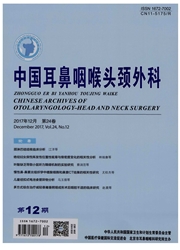

 中文摘要:
中文摘要:
目的观察大鼠缺血损伤后不同时间电刺激嗅觉诱发电位(olfactory evoked potentials,OEP)的变化。方法对照组A组21只,双侧颈总动脉结扎并按照术后1h、2 h、4 h和1天分为B组17只、C组10只、D组6只、E组6只的SD大鼠进行电刺激OEP检测。结果①A组中有18只(85.7%)大鼠可记录到一组由"负-正-负"三相波组成的诱电位波形图,3只(14.3%)为"负-正"两相波组成。N1、P1、N2潜伏期分别为(13.91±1.40)、(24.09±3.19)、(45.32±5.35)ms;N1、P1、N2振幅分别为(17.42±7.71)、(28.57±11.70)、(13.07±5.82)μV。②B组电刺激OEP的N1、P1潜伏期显著延长,E组N2潜伏期显著延长;E组N1振幅显著增大。结论双侧颈总动脉结扎可以导致电刺激OEP的变化,可能造成或加重嗅觉障碍。
 英文摘要:
英文摘要:
OBJECTIVE To investigate the characteristics of olfactory evoked potential at different time in bilateral common carotid artery ligation rats. METHODS The control group A(21 rats) and bilateral common carotid artery ligation group B(17 rats), group C(10 rats), group D(6 rats), group E(6) which according to the postoperative time(1 hours, 2 hours, 4 hours and 1 days), the electrically stimulated olfactory evoked potential of them were detected. RESULTS 1. 18 rats in group A(21 rats, 85.7%) can be recorded a group of 'negative–positive-negative' three-phase wave; 3 rats(14.3%) can be recorded a group of 'negativepositive' two-phase wave. The latency of N1, P1, N2 were(13.91±1.40),(24.09±3.19),(45.32±5.35) ms; the amplitude of N1, P1, N2 were(17.42±7.71),(28.57±11.70),(13.07±5.82) μV. 2. The latency of N1, P1 wave in group B were significantly prolonged, the latency of N2 was prolonged in group E; the amplitude of N1 significantly increased in group E. CONCLUSION Bilateral common carotid artery ligation can result in changes of olfactory evoked potential electrical stimulation in rats, and may cause the olfactory dysfunction.
 同期刊论文项目
同期刊论文项目
 同项目期刊论文
同项目期刊论文
 A New Microfluidic Chip-Based Online Electrochemical Platform for Extracellular Neurochemicals Monit
A New Microfluidic Chip-Based Online Electrochemical Platform for Extracellular Neurochemicals Monit In vivo ratiometric Zn2+ imaging in zebrafish larvae using a new visible light excitable fluorescent
In vivo ratiometric Zn2+ imaging in zebrafish larvae using a new visible light excitable fluorescent A simple and versatile microfluidic cell density gradient generator for quantum dot cytotoxicity ass
A simple and versatile microfluidic cell density gradient generator for quantum dot cytotoxicity ass Colorimetric and Fluorescent Dual Mode Sensing of Alcoholic Strength in Spirit Samples with Stimuli-
Colorimetric and Fluorescent Dual Mode Sensing of Alcoholic Strength in Spirit Samples with Stimuli- A multi-enzyme microreactor-based online electrochemical system for selective and continuous monitor
A multi-enzyme microreactor-based online electrochemical system for selective and continuous monitor An H2O2-responsive nanocarrier for dual-release of platinum anticancer drugs and O-2: controlled rel
An H2O2-responsive nanocarrier for dual-release of platinum anticancer drugs and O-2: controlled rel Continuous and Simultaneous Electrochemical Measurements of Glucose, Lactate, and Ascorbate in Rat B
Continuous and Simultaneous Electrochemical Measurements of Glucose, Lactate, and Ascorbate in Rat B Statistical single-cell analysis of cell cycle-dependent quantum dot cytotoxicity and cellular uptak
Statistical single-cell analysis of cell cycle-dependent quantum dot cytotoxicity and cellular uptak Online monodisperse droplets based liquid-liquid extraction on a continuously flowing system by usin
Online monodisperse droplets based liquid-liquid extraction on a continuously flowing system by usin Strategy for signaling molecule detection by using an integrated microfluidic device coupled with ma
Strategy for signaling molecule detection by using an integrated microfluidic device coupled with ma Platinum(II)-Gadolinium(III) Complexes as Potential Single-Molecular Theranostic Agents for Cancer T
Platinum(II)-Gadolinium(III) Complexes as Potential Single-Molecular Theranostic Agents for Cancer T Single-molecule dynamics of site-specific labeled transforming growth factor type II receptors on li
Single-molecule dynamics of site-specific labeled transforming growth factor type II receptors on li Visualization of the post-Golgi vesicle-mediated transportation of TGF-beta receptor II by quasi-TIR
Visualization of the post-Golgi vesicle-mediated transportation of TGF-beta receptor II by quasi-TIR Interfacing Microsampling Droplets and Mass Spectrometry by Paper Spray Ionization for Online Chemic
Interfacing Microsampling Droplets and Mass Spectrometry by Paper Spray Ionization for Online Chemic High-throughput and automatic typing via human papillomavirus identification map for cervical cancer
High-throughput and automatic typing via human papillomavirus identification map for cervical cancer A portable microchip for ultrasensitive and high-throughput assay of thrombin by rolling circle ampl
A portable microchip for ultrasensitive and high-throughput assay of thrombin by rolling circle ampl A mitochondrion-targeting copper complex exhibits potent cytotoxicity against cisplatin-resistant tu
A mitochondrion-targeting copper complex exhibits potent cytotoxicity against cisplatin-resistant tu A turn-on fluorescent Fe3+ sensor derived from an anthracene-bearing bisdiene macrocycle and its int
A turn-on fluorescent Fe3+ sensor derived from an anthracene-bearing bisdiene macrocycle and its int Visualization and quantification of neurochemicals with gold nanoparticles: Opportunities and challe
Visualization and quantification of neurochemicals with gold nanoparticles: Opportunities and challe Water-Stable, Adaptive, and Electroactive Supramolecular Ionic Material and Its Application in Biose
Water-Stable, Adaptive, and Electroactive Supramolecular Ionic Material and Its Application in Biose An in vitro liver model on microfluidic device for analysis of capecitabine metabolite using mass sp
An in vitro liver model on microfluidic device for analysis of capecitabine metabolite using mass sp Aggregation-Induced Structure Transition of Protein-Stabilized Zinc/Copper Nanoclusters for Amplifie
Aggregation-Induced Structure Transition of Protein-Stabilized Zinc/Copper Nanoclusters for Amplifie Assay of multiplex proteins from cell metabolism based on tunable aptamer and microchip electrophore
Assay of multiplex proteins from cell metabolism based on tunable aptamer and microchip electrophore Nanoscale imaging with an integrated system combining stimulated emission depletion microscope and a
Nanoscale imaging with an integrated system combining stimulated emission depletion microscope and a Internalization of the TGF-beta type I receptor into caveolin-1 and EEA1 double-positive early endos
Internalization of the TGF-beta type I receptor into caveolin-1 and EEA1 double-positive early endos Online electrochemical systems for continuous neurochemical measurements with low-potential mediator
Online electrochemical systems for continuous neurochemical measurements with low-potential mediator 期刊信息
期刊信息
